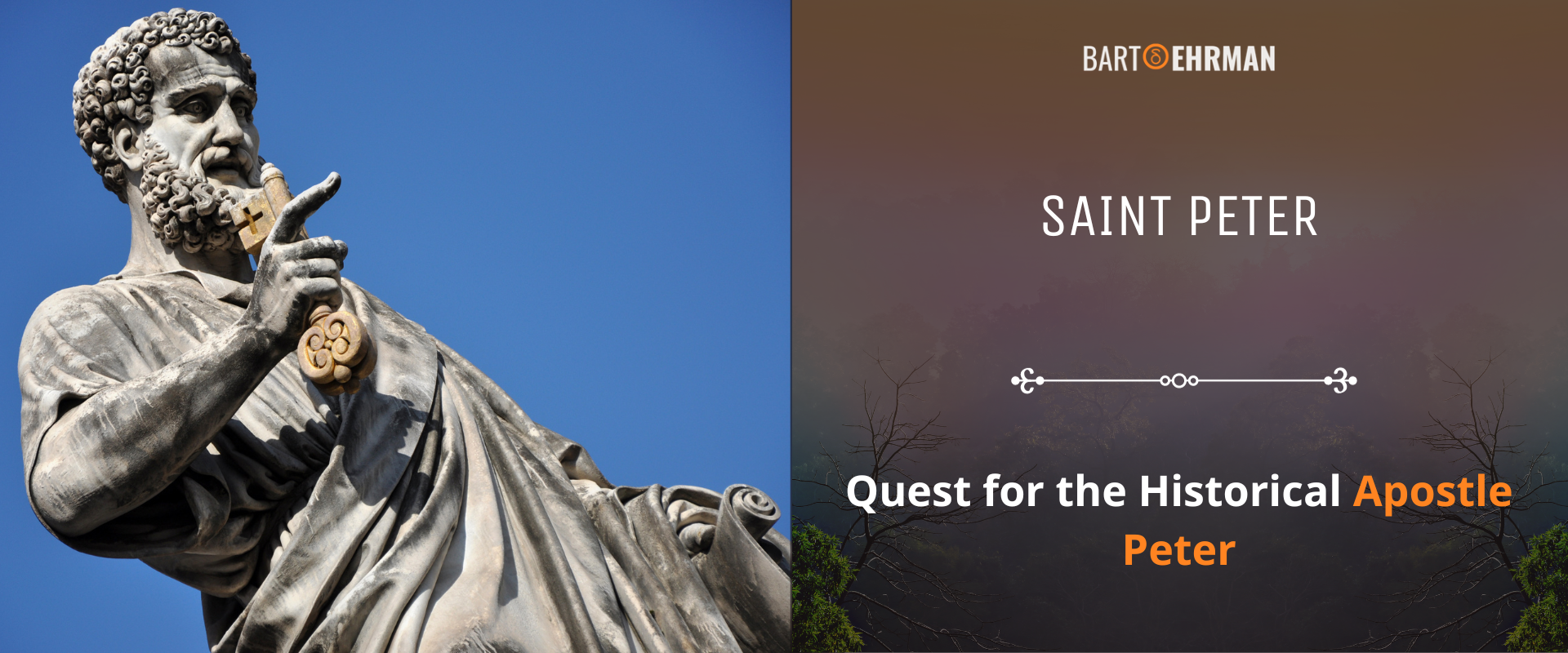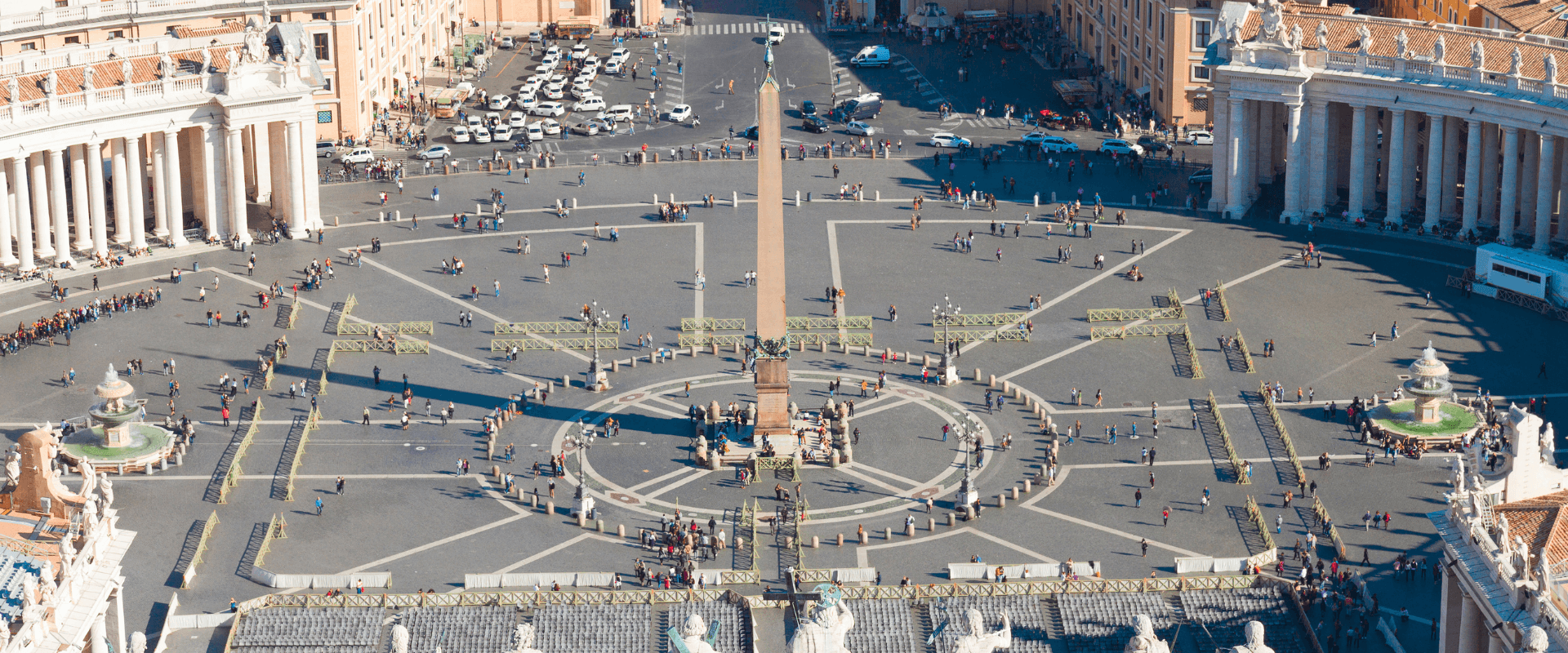Saint Peter: Quest for the Historical Apostle Peter

Written by Joshua Schachterle, Ph.D
Author | Professor | Scholar
Author | Professor | BE Contributor
Verified! See our editorial guidelines
Verified! See our guidelines
Date written: September 21st, 2023
Disclaimer: The views and opinions expressed in this article belong to the author and do not necessarily match my own. - Dr. Bart D. Ehrman
Saint Peter is one of the most significant individuals in the early church. In the Synoptic Gospels, he is among the first people Jesus calls to be his disciple. Unlike many saints, he is portrayed as being very human, making mistakes and saying the wrong things at the wrong time. But from the perspective of history, who was Saint Peter?
Markus Brockmuehl notes that “Simon Peter is arguably the only major player to feature in the ministries of both Jesus and Paul; and on any reckoning he provides a vital personal continuity between them both.”
So what is Saint Peter known for? What is the historical evidence of Peter? And what happened to the apostle Peter from the death of Jesus until his own death? In this article, I’ll explore these questions.

What is Saint Peter Known For?
Let’s start with some facts about Peter in the Bible, beginning with his name.
In Mark, our earliest Gospel, Saint Peter is first referred to as Simon, which seems to have been his given name. So where did the name Peter come from?
Paul makes several references to Peter, calling him Cephas. Why? Because like Jesus, Peter’s principal language was Aramaic. The Aramaic word cephas (or kephas) means “rock”. Since the authors of the Gospels all wrote in Greek, they translated this into the Greek word for rock (petra). Thus we have the name Petros or Peter.
In Mark 3:16, Jesus changes Simon’s name to Peter, although we’re not told why. In Matthew, however, which used Mark as a source, the name change is given much more significance.
In Matthew 18:16-19, Simon is the first disciple to declare that Jesus is “the Messiah, the Son of the living God.” As a result, Jesus changes his name to Peter, saying “on this rock (petra) I will build my church.” I’ll talk more about the significance of this incident in a later section.
What Do We Know of Peter’s Life Before Jesus?
All four Gospels say that Peter was a poor fisherman before he met Jesus. Peter even goes back to fishing after Jesus’ death in the Gospel of John.
Where did Peter live? The Gospel of John says he was originally from the town of Bethsaida. Luke, however, says that when he met Jesus he was living in the town of Capernaum. Both these towns were in the Galilee, the same region where Jesus spent his first years.
When was Saint Peter born? We can’t know for sure, but it seems likely that he was about the same age as Jesus, which would put his birth around the turn of the 1st century CE.
The Gospels also tell us that Peter was married, although they don’t say much about his wife. In fact, we only know about his marriage in the Gospels because Jesus comes to his house and heals Peter’s mother-in-law of an illness.
However, we also discover that Peter leaves his wife and his profession, at least temporarily, to follow Jesus. In 1 Corinthians 9:5, Paul, asking what apostles like himself deserve for their work of preaching the gospel, asks, “Do we not have the right to be accompanied by a believing wife, as do the other apostles and the brothers of the Lord and Cephas?”
So while Paul himself seems to have been unmarried, he says here that Peter, referred to as Cephas, is accompanied by a “believing wife.” If indeed Peter left his wife to follow Jesus, he seems to have returned to her (or possibly married someone else) by the time Paul meets him.
What Do We Know of Peter’s Life with Jesus?
The Gospel of Mark says that the morning after Jesus visits his home, Peter awakes to find that Jesus has left. When he finds Jesus praying alone, Jesus tells Peter and his companions Andrew (Peter’s brother), James, and John that they should go with him to other towns to preach. They all go unhesitatingly.
The next significant event involving Peter is his declaration about Jesus mentioned above. Besides changing his name, this incident as it is depicted in Matthew, has major implications for the future of the Church.
Was Peter the first Pope? We don’t have enough historical evidence to know for sure. However, the Catholic Church still operates on the assumption that he was.
Jesus declares that Peter is the “rock” upon which he will build his Church. Later Christian writers will interpret this as Jesus granting his own authority to Peter after his death. Since Peter is believed to have gone to Rome before his death, Church legend then makes him the first bishop of Rome or the first Pope.
The Synoptic Gospels also tell us that Jesus allows Peter, along with James and John, to witness Jesus’ transfiguration. In Mark 9, we get this account:
Six days later, Jesus took with him Peter and James and John and led them up a high mountain apart, by themselves. And he was transfigured before them, and his clothes became dazzling bright, such as no one on earth could brighten them. And there appeared to them Elijah with Moses, who were talking with Jesus. Then Peter said to Jesus, “Rabbi, it is good for us to be here; let us set up three tents: one for you, one for Moses, and one for Elijah.” He did not know what to say, for they were terrified. Then a cloud overshadowed them, and from the cloud there came a voice, “This is my Son, the Beloved; listen to him!” Suddenly when they looked around, they saw no one with them any more, but only Jesus.
While many have interpreted this as the revelation of Jesus’ divinity, it is also a revelation of his authority, putting him on equal footing with Moses and Elijah. Note that Peter is the one who speaks, awkwardly filling the awesome silence with an inane suggestion. As we will see, he is often depicted as impulsively making mistakes in the New Testament.
Another significant incident is related only by Matthew. While Jesus walks on water in Mark and John, Peter is more involved in the incident in Matthew 14:28-32.
The disciples go out without Jesus in a boat on the Sea of Galilee when a storm hits. As they’re fearing for their lives, they see Jesus walking toward them on the water. At first, the disciples think Jesus is a ghost, but he reassures them, telling them to be calm. Then this happens:
Peter answered him, “Lord, if it is you, command me to come to you on the water.” He said, “Come.” So Peter got out of the boat, started walking on the water, and came toward Jesus. But when he noticed the strong wind, he became frightened, and, beginning to sink, he cried out, “Lord, save me!” Jesus immediately reached out his hand and caught him, saying to him, “You of little faith, why did you doubt?” When they got into the boat, the wind ceased.
Peter demands proof of who Jesus is, but then begins to sink when he doubts. Again, his impulsivity is all too human.
One of the most significant Peter-related events in the Gospels is when Peter denies Jesus. At the Last Supper, Peter swears loyalty to Jesus no matter what happens. Jesus replies that before the next morning (in Mark, “before the cock crows twice”), Peter will deny Jesus three times.
Later that night after Jesus is arrested, Peter follows along and waits outside the place where Jesus is being held. Mark narrates the scene this way:
While Peter was below in the courtyard, one of the female servants of the high priest came by. When she saw Peter warming himself, she stared at him and said, “You also were with Jesus, the man from Nazareth.” But he denied it, saying, “I do not know or understand what you are talking about.” And he went out into the forecourt. Then the cock crowed. And the female servant, on seeing him, began again to say to the bystanders, “This man is one of them.” But again he denied it. Then after a little while the bystanders again said to Peter, “Certainly you are one of them, for you are a Galilean, and you talk like one.” But he began to curse, and he swore an oath, “I do not know this man you are talking about.” At that moment the cock crowed for the second time. Then Peter remembered that Jesus had said to him, “Before the cock crows twice, you will deny me three times.” And he broke down and wept.
By now it should be evident that Peter was not remembered as perfect. Rather, he was a highly fallible human being who nevertheless was able to become a leader in the nascent Church.
The last event of Peter’s life with Jesus occurs after Jesus’ crucifixion. Paul says that the resurrected Jesus appeared to Peter first. In the Gospel of John, Peter is the first to enter Jesus’ empty tomb. Whether historical or not, these reported sightings clearly demonstrate Peter’s authority in the newly formed Church.
Peter’s Life after Jesus: What is the Historical Evidence of Peter?
In the New Testament we have two sources for the life of Saint Peter after Jesus’ death. The first is the Acts of the Apostles, written by the author of Luke, and the second is the undisputed letters of Paul. However, as I wrote about in another article, the two don’t always agree.
How is Peter Portrayed in Acts?
In Acts 1, Peter is with the remaining disciples after Jesus’ execution and resurrection. They have seen the resurrected Jesus who promises that they will receive power when the Holy Spirit comes upon them. He then ascends to heaven.
Back in the house where they’re staying, the entire group experiences a startling epiphany. They hear a sound “like a violent wind” and “divided tongues, as of fire, appeared among them, and a tongue rested on each of them.” All of them begin to speak in languages they didn’t previously know.
The violent sound brings a curious crowd to the house. At this point, Peter, assuming leadership, stands up and speaks to the crowd on behalf of the group about Jesus. For our purposes, his words are less significant than the fact that he is portrayed as the spokesperson for this earliest group of Jesus-followers.
In fact, Peter speaks for the group on several occasions in Acts, both as a preacher and as their defender when hostile religious leaders arrest them. In fact, so great is Peter’s spiritual power in Acts that at one point, people place sick friends and relatives in his path so that his shadow will pass over them and heal them.
However, by Acts 9, Peter all but disappears, his starring role taken over by Paul. He only reappears for a brief speech during the Jerusalem Council, a meeting in which decisions are made about requirements for gentile converts to belief in Jesus.
Overall, the impression in Acts is that Peter is the leader of the Church and that he and Paul are in perfect agreement about their faith and mission. But what do Paul’s letters say about Peter?
How is Peter Portrayed in the Letters of Paul?
The most explicit reference Paul makes to Peter, again calling him by his Aramaic name Cephas, is in his letter to the Galatians.
In Galatians 1, Paul says that he received his apostleship not from human authority but directly from Christ. He notes that after his conversion (or calling) he waited three years before visiting Peter in Jerusalem. This is important because Paul is acknowledging Peter’s leadership, even as he denies that it’s necessary for his own mission.
But then in Galatians 2, he says that fourteen years after his first visit, he went to Jerusalem again. In fact, this is probably the Jerusalem Council written about in Acts. Since Paul feels that he has been sent by God to preach exclusively to gentiles, the issue of gentile requirements is important to him. But Paul arrives ready for a fight.
It appears that some, if not all, in the Jerusalem Church believed that gentiles had to be circumcised and follow the Torah if they were to join the Jesus-followers. Paul disagreed. In Galatians 2, he tells it like this:
Then I laid before them (though only in a private meeting with the acknowledged leaders) the gospel that I proclaim among the gentiles, in order to make sure that I was not running, or had not run, in vain. But because of false brothers and sisters secretly brought in, who slipped in to spy on the freedom we have in Christ Jesus, so that they might enslave us— we did not submit to them even for a moment, so that the truth of the gospel might always remain with you [the Galatians]. And from those who were supposed to be acknowledged leaders (what they actually were makes no difference to me; God shows no partiality)—those leaders contributed nothing to me.
This is a bold statement! Paul is saying that he stood up to the Jerusalem leaders – he later names them as James (Jesus’ brother), Peter, and John. According to Paul, “those leaders contributed nothing” to him in terms of what he is preaching to the gentiles.
So which is truer, the account in Acts or that in Paul’s letter? Acts was written long after the events it describes. Paul’s letter is a firsthand account, but unfortunately, we only have Paul’s side of the story in Galatians.
Later, in Galatians 2:11-14 Paul says he confronted Peter (Cephas) in Antioch:
But when Cephas came to Antioch, I opposed him to his face because he stood self-condemned, for until certain people came from James, he used to eat with the gentiles. But after they came, he drew back and kept himself separate for fear of the circumcision faction. And the other Jews joined him in this hypocrisy, so that even Barnabas was led astray by their hypocrisy. But when I saw that they were not acting consistently with the truth of the gospel, I said to Cephas before them all, “If you, though a Jew, live like a gentile and not like a Jew, how can you compel the gentiles to live like Jews?”
In fact, the entire letter to the Galatians is an attempt by Paul to convince the community at Galatia that he has just as much authority as Peter and the other Jerusalem leaders. This shows us that Peter is known as a leader of the original Jerusalem Church.
What Happened to the Apostle Peter? Stories About His Death
Peter’s death is not mentioned in the canonical Bible. It is mentioned, however, in later Christian sources.
One of our earliest sources about Peter outside the New Testament is 1 Clement, an anonymous letter from a member of the Church in Rome to the Church at Corinth. Most scholars date it to the 90s CE.
In this letter, the end of Peter’s life is remembered tersely:
Peter, through unrighteous envy, endured not one or two, but numerous labors, and when he had finally suffered martyrdom, departed to the place of glory due to him.
While we are told that he died a martyr, the letter doesn’t say exactly where or how Peter died. The author may have assumed that everyone in the Church already knew these details.
Another source that refers to Peter’s death is the Acts of Peter, a 2nd-century text in which Peter goes to Rome as a missionary. Since Church tradition says that Peter died in Rome, this is significant.
According to this text, Peter is arrested and condemned to be crucified. At this point, he makes an odd request: he asks to be crucified upside down. The Romans are happy to oblige.
Why does he ask for this? In the Acts of Peter, he makes a short speech explaining that it is a symbolic gesture. He says that humans had been corrupted by sin, symbolized by Peter’s inversion on the cross. Christ, however, had come to put the world right, symbolized by his crucifixion right side up.
However, Jerome, a later Christian author writing in the 4th century, knows about Peter’s inverted crucifixion, but has a different explanation. He says that Peter requested this because he thought himself unworthy to be executed in the same manner as Jesus.
How old was Peter when he died? This involves some speculation.
Paul’s letters were written in the 50s CE and, as I said before, refer to his meetings with Peter. Based on the fact that we have no other firsthand references to Peter after that, most scholars assume that he died around 62 CE. If we assume that Peter was about the same age as Jesus, he would probably have been in his sixties when he died.

Conclusion: Who was the Apostle Peter?
What was Saint Peter known for? He is one of the first and most important of Jesus’ disciples and the first disciple in the Gospels to identify Jesus as the Messiah. He is also allowed to see Jesus’ divinity revealed through the transfiguration. Whether or not these events are historical, they certainly demonstrate the authority he had in the early Church.
What is the historical evidence for Saint Peter? Our best evidence comes from the firsthand accounts of Paul.
Paul actually met Peter and had a major disagreement with him over the way Jewish and gentile followers of Jesus should relate to each other. Paul also says that Peter was the first person to whom the risen Jesus appeared and indicates that Peter was married.
In addition, most scholars agree that in accordance with his portrait in the New Testament, Peter was originally a poor fisherman from the Galilee in Palestine.
What happened to Saint Peter? Tradition says that he eventually went to Rome, where he became the first Pope, and was then arrested and crucified upside down. Unfortunately, accounts of these events are written decades or even centuries after Peter’s death. While they may represent actual memories of Peter, they aren’t entirely trustworthy as historical sources.
We know that Peter was a real, historical person, an undeniably significant figure for the early Church. However, as with many individuals found in the Bible, separating history from legend is a never-ending task.
